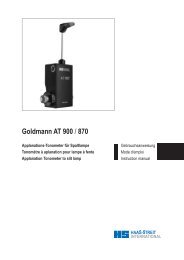7900 Instrument Stand - Haag-Streit USA
7900 Instrument Stand - Haag-Streit USA
7900 Instrument Stand - Haag-Streit USA
- TAGS
- haag-streit-usa.com
You also want an ePaper? Increase the reach of your titles
YUMPU automatically turns print PDFs into web optimized ePapers that Google loves.
18<br />
3.8. eCliPse rOOm lighT COnTrOl sYsTem<br />
The Eclipse Room Light Control System, available as an<br />
option on the Model <strong>7900</strong> instrument stands with console.<br />
The Eclipse System allows one to control examination room’s<br />
incandescent and/or fluorescent lights from the <strong>Instrument</strong><br />
<strong>Stand</strong>. This infrared (IR) system has a maximum of 16 different<br />
lighting combinations or scenes (dual zone). The Eclipse is<br />
available in either a single or dual zone system.<br />
The Eclipse console has an additional switch for room<br />
light controls (See Figure 11, switch marked “ROOM”) and<br />
a transmitter that attaches to the top of the support pole.<br />
The software in the unit is designed to operate a designated<br />
function on the stand. A signal is sent to a receiver that is<br />
installed in the in place of the room light switch. The signal is<br />
an infrared signal, the same technology as remote control.<br />
The signal tells the receiver what “scene” the lights being<br />
controlled need to go into. A scene is a lighting environment<br />
programmed into the receiver. Each function has its own<br />
scene which the user has the ability to manipulate. For<br />
example, removing the instrument from well #1 is scene 1.<br />
When the handle is removed the software tells the receiver<br />
to go to scene 1, and controls the light as scene 1 has<br />
been programmed.<br />
inFrareD signal<br />
Figure 11<br />
3.8.1. Dual Zone vs. single Zone<br />
3.8.1.1 A Zone refers to a bank of lights controlled by one<br />
room light switch. For example a room with a group of canned<br />
lights controlled by one switch and fluorescent controlled by<br />
another switch has two lighting zones. A dual zone system<br />
allows a scene to operate both zones and program them so<br />
the zones are programmed independently. When a handle is<br />
removed from well #1 the user can have one bank of lights<br />
dim and the other turn completely off. When the handle is<br />
replaced the lights go back to the original settings. A single<br />
zone system can only control one lighting zone.<br />
Dual Zone receiver/standard 2 Zone switch<br />
3.8.1.2. number of scenes<br />
Dual zone has 16 scenes or 8 functions on the instrument<br />
stand that can control room lights.<br />
• Room light switch.<br />
• B/P switch.<br />
• Auxiliary switch.<br />
• Lamp switch.<br />
• Switch on the slit lamp arm.<br />
Single zone is controlled by the room light switch.<br />
• Well #1.<br />
• Well #2.<br />
• B/P switch.<br />
• Switch on the slit lamp arm.<br />
The B/P switch and Slit lamp switch share the same<br />
scene.<br />
3.8.1.3 Program Features<br />
Dual zone system is programmed at the receiver mounted<br />
in the wall (see figure 17), while the single zones uses a<br />
hand held remote to program (see figure 16). The dual<br />
zone system allows one to set a fade rate of the lighting,<br />
while the single zone does not. The single zone requires<br />
the B/P switch and Slit lamp arm switch to share a scene,<br />
while dual zone does not.<br />
3.8.1.4 indirect hanger<br />
Both systems accept a indirect hanger which is mounted to<br />
the back of the pole. The hanger is designed so when the<br />
indirect is lifted off, the room lights go to the desired scene<br />
and the indirect comes on. Use of the hanger supersedes<br />
the B/P switch.<br />
IN-<strong>7900</strong>









